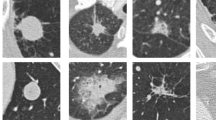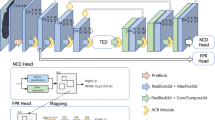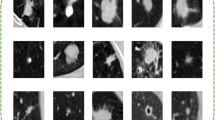Abstract
Lung cancer has the highest mortality rate among all types of cancers. Early detection of lung cancer may improve survival rates. The two categories of pulmonary lung nodules have high visual similarities. So, distinguishing them is a challenging task for radiologists. The main purpose of this work is to use convolutional neural network to perform binary classification of pulmonary nodules in CT images. This paper proposes a new multi-scale (64 \(\times \) 64, 32 \(\times \) 32 and 16 \(\times \) 16) convolutional neural network architecture for benign and malignant nodules classification. In addition, transfer learning method is used to initialize the weights of multi-scale architecture. Experimental results on the dataset LIDC-IDRI demonstrate that the proposed method achieved accuracy of 93.88%, sensitivity of 93.36% and specificity of 93.26% on nodule malignancy classification. The proposed method also outperforms the other state-of-the-art methods explicitly designed for malignancy classification of pulmonary lung nodules.












Similar content being viewed by others
Data availibility statement
The datasets used in the current study are available in the below https://wiki.cancerimagingarchive.net/display/Public/LIDC-IDRI.
References
Abid MMN, Zia T, Ghafoor M, Windridge D (2021) Multi-view convolutional recurrent neural networks for lung cancer nodule identification. Neurocomputing 453:299–311
Armato SG III, McLennan G, McNitt-Gray MF, Meyer CR, Yankelevitz D, Aberle DR, Henschke CI, Hoffman EA, Kazerooni EA, MacMahon H et al (2004) Lung image database consortium: developing a resource for the medical imaging research community. Radiology 232(3):739–748
Attique Khan M, Sadia R, Asifa K, Imran SM, Nazeer M, Hussain SJ, Yu-Dong Z, Chandra SS (2020) Lungs cancer classification from ct images: An integrated design of contrast based classical features fusion and selection. Pattern Recogn Lett 129:77–85
Baihua Z, Shouliang Q, Patrice M, Chen L, Fan Y, Yu-Dong Y, Wei Q (2019) Ensemble learners of multiple deep cnns for pulmonary nodules classification using ct images. IEEE Access 7(8):110358–110371. https://doi.org/10.1109/access.2019.2933670
Chen Y, Wang Y, Fei H, Wang D (2020) A lung dense deep convolution neural network for robust lung parenchyma segmentation. IEEE Access 8:93527–93547
Pritam Mukherjee M, Zhou EL, Schicht A, Balagurunathan Y, Napel S, Gillies R, Wong S, Thieme A, Leung A et al (2020) A shallow convolutional neural network predicts prognosis of lung cancer patients in multi-institutional computed tomography image datasets. Nat Mach Intell 2(5):274–282
Ren Y, Tsai M-Y, Chen L, Wang J, Li S, Liu Y, Jia X, Shen C (2020) A manifold learning regularization approach to enhance 3d ct image-based lung nodule classification. Int J Comput Assist Radiol Surg 15(2):287–295
Sarfaraz H, Pujan K, Bolan Candice W, Wallace Michael B, Ulas B (2019) Lung and pancreatic tumor characterization in the deep learning era: novel supervised and unsupervised learning approaches. IEEE Trans Med Imaging 38(8):1777–1787
Venugopal VK, Vaidhya K, Murugavel M, Chunduru A, Mahajan V, Vaidya S, Mahra D, Rangasai A, Mahajan H (2020) Unboxing ai-radiological insights into a deep neural network for lung nodule characterization. Acad Radiol 27(1):88–95
Xie Y, Xia Y, Zhang J, Song Y, Feng D, Fulham M, Cai W (2018) Knowledge-based collaborative deep learning for benign-malignant lung nodule classification on chest ct. IEEE Trans Med Imaging 38(4):991–1004
Xie Y, Zhang J, Xia Y, Fulham M, Zhang Y (2018) Fusing texture, shape and deep model-learned information at decision level for automated classification of lung nodules on chest ct. Inf Fusion 42(102–110):7. https://doi.org/10.1016/j.inffus.2017.10.005
Yan K, Tian L, Xueqiao P, Elvis SG, Qiao L, Junyi Z (2020) Unsupervised multi-discriminator generative adversarial network for lung nodule malignancy classification. IEEE Access 8:77725–77734. https://doi.org/10.1109/ACCESS.2020.2987961
Yu G, Xiaoqi L, Yang L, Zhang B, Dahua Yu, Zhao Y, Gao L, Liang W, Zhou T (2018) Automatic lung nodule detection using a 3d deep convolutional neural network combined with a multi-scale prediction strategy in chest cts. Comput Biol Med 103:220–231
Yutong X, Jianpeng Z, Yong X (2019) Semi-supervised adversarial model for benign-malignant lung nodule classification on chest ct. Med Image Anal 57(10):237–248. https://doi.org/10.1016/j.media.2019.07.004
Zhao W, Yang J, Sun Y, Li C, Wu W, Jin L, Yang Z, Ni B, Gao P, Wang P, Hua Y, Li M (2018) 3d deep learning from ct scans predicts tumor invasiveness of subcentimeter pulmonary adenocarcinomas. Cancer Res 78(12):6881–6889. https://doi.org/10.1158/0008-5472.CAN-18-0696
Zhao X, Liu L, Qi S, Teng Y, Li J, Qian W (2018) Agile convolutional neural network for pulmonary nodule classification using ct images. Int J Comput Assist Radiol Surg 13(4):585–595
Author information
Authors and Affiliations
Corresponding author
Ethics declarations
Conflict of interest
The authors have no conflict of interest.
Additional information
Publisher's Note
Springer Nature remains neutral with regard to jurisdictional claims in published maps and institutional affiliations.
Rights and permissions
Springer Nature or its licensor holds exclusive rights to this article under a publishing agreement with the author(s) or other rightsholder(s); author self-archiving of the accepted manuscript version of this article is solely governed by the terms of such publishing agreement and applicable law.
About this article
Cite this article
Sakshiwala, Singh, M.P. A new framework for multi-scale CNN-based malignancy classification of pulmonary lung nodules. J Ambient Intell Human Comput 14, 4675–4683 (2023). https://doi.org/10.1007/s12652-022-04368-w
Received:
Accepted:
Published:
Issue Date:
DOI: https://doi.org/10.1007/s12652-022-04368-w




